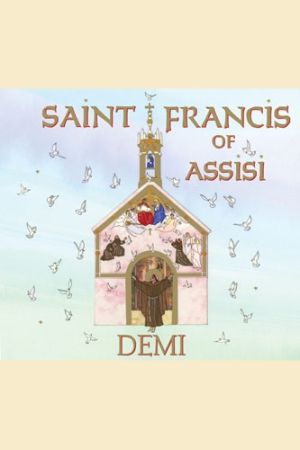Saint Francis of Assisi
- 2012 INDIES Finalist
- Finalist, Juvenile Nonfiction (Children's)
Saint Francis of Assisi was a complex individual who faced many instances of adversity in his life in Italy. In this children’s book, illustrator Demi delivers a retelling of his story, from his birth in 1182 to his participation in war with a neighboring town. The diagrams that accompany the text leave a biblical impression appropriate for this story, with gold frames, clothing, and architecture suggestive of the time period they recap. The story is appropriate for children aged six through ten, but at times can be challenging for a child to comprehend. For example, after Francis prayed in the mountains we learn: “love and sincere longing for the simple life of Jesus overcame him.” Similarly, we are told, “Francis was divinely inspired to reject making the rules any easier.” Different word choices would have made these concepts easier to grasp.
Over the course of the story there are many instances of Francis’s bravery and determination. Devoted to the poor, he established a brotherhood of friars who were nomadic and discarded materialism and even hygiene from their lives. When Pope Innocent III saw how muddy and unclean they were, he said they were “fit for rolling with the pigs.” Unperturbed, Francis went to roll in a pig sty, teaching the Pope a lesson about poverty.
Francis and his friars had a special relationship with birds, fish, and animals and Demi uses her drawing skills to depict creatures of all kinds, including humans, who responded to his words. He tamed wolves without fear, and crossed the ocean to preach to the Muslims in Spain. He was also unafraid to criticize when he felt it was needed. If his friars were living too rich a life, he told them so.
Saint Francis of Assisi would be a helpful resource for Christian children at Sunday schools and a beautiful addition to any church library. To ensure children’s understanding of some of the complex themes addressed in the story, however, it might be prudent to offer simpler explanations as well; and, if the book is being read to a group, a forum for discussion on what some of those themes mean today might be useful.
Reviewed by
Lauren Kramer
Disclosure: This article is not an endorsement, but a review. The publisher of this book provided free copies of the book and paid a small fee to have their book reviewed by a professional reviewer. Foreword Reviews and Clarion Reviews make no guarantee that the publisher will receive a positive review. Foreword Magazine, Inc. is disclosing this in accordance with the Federal Trade Commission’s 16 CFR, Part 255.

